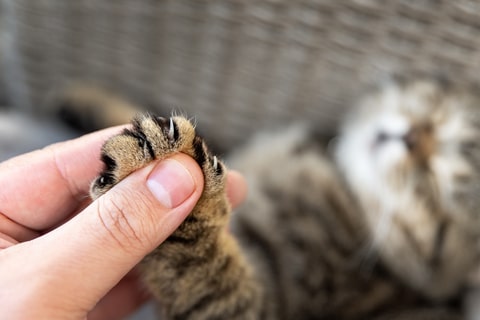Everything, Cats, Health care, Pet Care
To Declaw or Not Declaw Your Cat
Does declawing harm cats? Is it really worse than spaying or neutering? Are there other successful methods to prevent cats from clawing furniture?
Yes, yes, and yes.
In our article entitled When Your Cat Scratches the Furniture, we discussed what you can do when your cat is scratching the furniture. When you convince your cat that furniture scratching isn’t fun and that the alternatives you provide are, you may not need to have your cat’s claws surgically removed to protect your furniture.
Declawing cats is illegal in some countries. While it’s legal in the US, some veterinarians refuse to declaw cats for humane reasons. Should declawing still be an option to consider? Let’s look at what happens during and after this procedure.
Cat declawing surgery
A common misconception is that declawing a cat involves removing only the cat’s claws. In fact, a more accurate word for the procedure is de-toeing, since not just the claws but the last joint of each toe is amputated.
Cats’ claws are more than fingernails and toenails. They’re a movable part of the foot, and they’re attached to the rest of the foot with muscles, ligaments, and tendons that cats use to flex their claws. Cat declawing surgery involves cutting through all of these as well as through nerves.
Physical problems after cats are declawed
Recovery after cat declawing surgery is slow, and post-surgical complications are common. Even without any complications, cats are in a lot of pain, and unlike people, they can’t stay off their feet until they recover.
Removing the ends of cats’ toes takes away much more than cats’ ability to scratch. After the stubs they’re left with have healed, declawed cats still can’t walk normally and will never walk normally again, so they lose their natural posture and grace. They’re defenseless without their claws, so they have to be kept indoors for their own protection. They can’t establish the right footing to jump, spring, or keep their balance. They can fall more easily and become injured.
Psychological and behavioral problems with declawing cats
Declawing cats may save your furniture, but it leads to other problems as cats adapt to their loss.
Declawed cats are constantly more stressed and nervous because they know they can’t defend themselves. They tend to bite more because they don’t have their primary natural means of warning and protection. They may also become more withdrawn. Some declawed cats stop using the litter box, presumably because of the pain they feel when trying to bury their waste.
Declawing versus spaying and neutering
We routinely spay and neuter our pets, and some people reason that if these procedures are acceptable, declawing should be acceptable too. Let’s compare them.
- Surgery Spaying and neutering do not cause a great amount of pain. Declawing does.
- Post-surgery Depending on how the procedure is done and on the age of the cat, recovery time after cat declawing surgery can be 10 days or more. After young cats are spayed or neutered, they can be expected to be back to their normal behavior within a day or so.
- Physical after-effects Declawed cats are permanently maimed. Spayed and neutered cats have no physical limitations as a result of their surgery except that they can’t reproduce (an ability they won’t miss if they’re spayed or neutered young enough).
- Emotional after-effects Declawed cats often go through a personality change because they’re left defenseless. Spayed and neutered animals, on the other hand, experience no emotional changes as a result of the surgery if it’s done before they reach sexual maturity. They’re more content than if they were left with the urge to mate but weren’t allowed to.
- Health benefits For declawed cats: none. The neutering of male cats prevents testicular tumors and reduces the chances of the cats getting prostate cancer. The spaying of female cats prevents uterine diseases.
Alternatives to declawing
The consequences of declawing don’t mean that you have to let your cat ruin your furniture.
Scratching is behavior that comes with cats. We can help cats learn to adapt to our world, and for the most part, they will. The alternative to declawing is to train your cat to use a scratching post, and to convince your cat that furniture is not good to scratch. Details are in the article When Your Cat Scratches Your Furniture.

